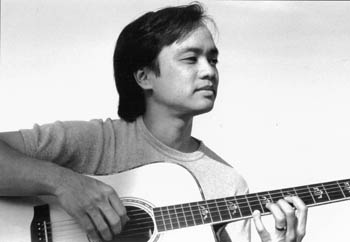![[Metroactive Music]](/music/gifs/music468.gif)
[ Music Index | San Jose | Metroactive Central | Archives ]
 Around the World Music: Musician Daniel Ho uses diverse sounds, from koto to slack-key guitar, in his unique compositions. American Taiko San Jose Taiko drums up the spirit of collaboration in its fusion of cultures and sounds By Marianne Messina WHEN ROY and P.J. Hirabayashi started San Jose Taiko, a drumming group with traditional Japanese roots, it was only the third of its kind in the country. That was 27 years ago, and yet the type of Asian American cross-pollination the couple first envisioned is just now coming into bloom. At a San Jose Taiko performance, you will certainly find the traditional drums: the small josuke, the gourdlike hyo tan, the metallic atare kane, the pitch-shifting shime taiko. But you will also hear the influences of American pop, rock and jazz, and you are as likely to see the Margaret Wingrove Dance Company as you are to witness Tai Chi and martial arts movements. Like many of the now more than 100 U.S. taiko groups, San Jose Taiko was, for the Hirabayashis, initially an "outlet to convey their experiences as third generation Japanese-Americans." Yet San Jose Taiko has always differed in the degree to which it collaborates, borrows from the ambient culture and works collectively. In this, the Hirabayashis have been very forward-thinking. The couple's twin hopes, to "celebrate their heritage" and "to transcend cultural boundaries," sound a lot like the dialectic tension inherent in many recent explorations by Asian-descended jazz musicians: personal history meets cultural present. The eclectic ensemble, Asian Crisis, with founding-member pianist Art Hirahara, embodies this tension. Asian Crisis incorporates percussion from Korea, China, Japan, the Philippines and India, along with traditional music, Western instrumentation and urban American experience. In this way, according to Hirahara, "traditional pieces are heard through the lens of the music our members grew up with: jazz, funk, pop, hip-hop, reggae." Hirahara, who as a jazz pianist adds yet another "linguistic" tradition to the mix, suggests, "the process we use to create our music in many ways mirrors the process of Asian Americans forging a cultural and political identity in the United States." This is a nascent process. Hirahara suggests that even today, "a lot of fusion of Asian music and jazz only scratches the surface of possibilities in cross-cultural interaction." The Hirabayashis might point out that that "possibility" is one of the spiritual essences of Japanese drumming--along with renewal and transformation. That is perhaps part of the reason for the endless list of collaborators the Taiko group has worked with along the way, a list they share with the community in programs like "Summer Series 2000," of which Hirahara and his group are guests this year. ONE RECENT collaborator, and also a guest of the Summer Series, is Daniel Ho. A Hawaiian native (no relation to Don), Ho is an eclectic dynamo who, it seems, will play anything, from ukulele to piano to drums to guitar--or do anything, from producing to composing to arranging to cover art, with anybody, from historians to koto players. On his upcoming CD, Beyond Blue, he co-wrote a song called "Sacred Journey" with koto player June Kuramoto of the band Hiroshima, combining the rich sound of Hawaiian tunings with the delicate Japanese strings. His collaboration with George Kahumoku, a master of slack key tuning (a Hawaiian-innovated way of tuning a guitar so as to maximize the number of open strings in any chord), just recently won the artists a Hoku award. "I'm always trying to convey the many aspects of who I am," says Ho. It is interesting to see how various musicians with yearnings similar to Ho's confront--or in some cases stumble upon--the heritage issue. Hirahara, whose Oberlin College degree was in electronic music, suddenly found the "need to connect with music that was more 'human' and personal." Stanford professor Steve Sano, who co-wrote a slack key instructional book with Daniel Ho, picked up some ki hoyalu (slack key) CDs while visiting family in Honolulu and, as he puts it, "has never been the same since." The Hirabayashis' idea for San Jose Taiko grew as they worked with and sought to inspire their Buddhist Temple youth group. "San Jose Taiko strives to expand, extend, and enhance the boundaries of its art," say the Hirabayashis. Like most true artists, by searching inward to develop and contextualize a personal voice, the Hirabayashis and their musical friends have ultimately gone outward, far and wide, to embrace and merge with the "other."
The San Jose Summer 2000 series continues this week with the Art Hirahara Sextet and Asian Crisis on Friday (Aug. 25) at 8pm, $15 adults/$12 children and seniors; Daniel Ho, Saturday (Aug. 26) at 8pm; $15 adults/$12 children and seniors; and the San Jose Taiko Family Show (performance, demonstration, and hands-on for kids), Sunday (Aug. 27) at 1pm and 3:30pm, $10 adults/$5 children (under 12). All performances will be held at the San José Repertory Theater, 101 Paseo de San Antonio. (408.367.7255) [ San Jose | Metroactive Central | Archives ]
|
From the August 24-30. 2000 issue of Metro, Silicon Valley's Weekly Newspaper.
Copyright © 2000 Metro Publishing Inc. Metroactive is affiliated with the Boulevards Network.
For more information about the San Jose/Silicon Valley area, visit sanjose.com.